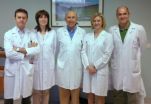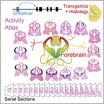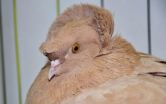(Press-News.org) Researchers at the University of Florida and Oberlin College have developed a sequencing method that will allow potentially hundreds of plant chloroplast genomes to be sequenced at once, facilitating studies of molecular biology and evolution in plants.
The chloroplast is the compartment within the plant cell that is responsible for photosynthesis and hence provides all of the sugar that a plant needs to grow and survive. The chloroplast is unusual in containing its own DNA genome, separate from the larger and dominant genome that is located in every cell's nucleus.
Chloroplast DNA sequences are widely used by plant biologists in genetic engineering and in reconstructing evolutionary relationships among plants. Until recently, though, chloroplast genome sequencing was a costly and time-intensive endeavor, limiting its utility for plant evolutionary and molecular biologists. Instead, most researchers have been limited to sequencing a small portion of the chloroplast genome, which in many cases is insufficient for determining evolutionary relationships, especially in plant groups that are evolutionarily young.
In contrast, complete chloroplast genome sequences harbor enough information to reconstruct both recent and ancient diversifications. New DNA sequencing technologies, termed "next-generation" sequencers, have made it considerably cheaper and easier to sequence complete chloroplast genomes. While current methods using next-generation sequencers allow up to 48 chloroplast genomes to be sequenced at one time, the new method will allow potentially hundreds of flowering plant chloroplast genomes to be sequenced at once, significantly reducing the per-sample cost of chloroplast genome sequencing.
This new method, reported in the February issue of Applications in Plant Sciences (available for free viewing as part of the February Issue in Progress at http://www.bioone.org/doi/pdf/10.3732/apps.1200497), relies on efficient separation of chloroplast DNA from other DNA in the cell using short DNA "baits" that were designed from chloroplast genomes that have already been sequenced. These molecular baits effectively concentrate the chloroplast DNA before sequencing (a process termed "targeted enrichment"), dramatically increasing the number of samples that can be sequenced at once.
Greg Stull, a graduate student at the University of Florida and lead author of the study, summarizes the versatility of the new system: "With this method, it should be possible for researchers to cheaply sequence hundreds of chloroplast genomes for any flowering plant group of interest."
The method was specifically designed by the authors of the study such that almost any flowering plant chloroplast genome can be sequenced, regardless of species. Flowering plants represent the largest (~300,000 species) and most ecologically dominant group of land plants, and include all major crop plants.
### Applications in Plant Sciences (APPS) is a monthly, online-only, peer-reviewed, open access journal focusing on new tools, technologies, and protocols in all areas of the plant sciences. It is published by the Botanical Society of America (www.botany.org), a non-profit membership society with a mission to promote botany, the field of basic science dealing with the study and inquiry into the form, function, development, diversity, reproduction, evolution, and uses of plants and their interactions within the biosphere. The first issue of APPS published in January 2013; APPS is available as part of BioOne's Open Access collection (http://www.bioone.org/toc/apps/current).
For further information, please contact the APPS staff at apps@botany.org.
Sequencing hundreds of chloroplast genomes now possible
New method allows plant biologists to 'capture' and sequence the DNA of hundreds of complete chloroplast genomes at 1 time
2013-02-01
ELSE PRESS RELEASES FROM THIS DATE:
Examining the so-called Basque mutation of Parkinson's
2013-02-01
This press release is available in Spanish.
The relationship between genetics and Parkinson's has been investigated for more than a decade, but it is only over the last few years that significant results have begun to be obtained. The first mutations related to the development of this disease were found in 2004. A team from the UPV/EHU-University of the Basque Country came across a mutation of the LRRK2 gene, which is particularly prevalent among the population of Gipuzkoa. It is the R1441G mutation and is known as the Basque mutation. Now, Doctor Javier Ruiz, a doctor ...
NASA sees a coronal mass ejection erupt from the sun
2013-02-01
On Jan. 31, 2013 at 2:09am EST, the sun erupted with an Earth-directed coronal mass ejection or CME. Experimental NASA research models, based on observations from the Solar Terrestrial Relations Observatory (STEREO) and ESA/NASA's Solar and Heliospheric Observatory, show that the CME left the sun at speeds of around 575 miles per second, which is a fairly typical speed for CMEs. Historically, CMEs at this speed are mild.
Not to be confused with a solar flare, a CME is a solar phenomenon that can send solar particles into space and reach Earth one to three days later.
Earth-directed ...
The effective collective: Grouping could ensure animals find their way in a changing environment
2013-02-01
For social animals such as schooling fish, the loss of their numbers to human activity could eventually threaten entire populations, according to a finding that such animals rely heavily on grouping to effectively navigate their environment.
Princeton University researchers report in the journal Science that collective intelligence is vital to certain animals' ability to evaluate and respond to their environment. Conducted on fish, the research demonstrated that small groups and individuals become disoriented in complex, changing environments. However, as group size is ...
Evidence of geological 'facelift' in the Appalachians
2013-02-01
How does a mountain range maintain its youthful, rugged appearance after 200 million years without tectonic activity? Try a geological facelift – courtesy of the earth's mantle.
Researchers from North Carolina State University noticed that a portion of the Appalachian Mountains in western North Carolina near the Cullasaja River basin was topographically quite different from its surroundings. They found two distinct landscapes in the basin: an upper portion with gentle, rounded hills, where the average distance from valley to mountain top was about 500 feet; and a lower ...
Genome-wide atlas of gene enhancers in the brain online
2013-02-01
Future research into the underlying causes of neurological disorders such as autism, epilepsy and schizophrenia, should greatly benefit from a first-of-its-kind atlas of gene-enhancers in the cerebrum (telencephalon). This new atlas, developed by a team led by researchers with the U.S. Department of Energy (DOE)'s Lawrence Berkeley National Laboratory (Berkeley Lab) is a publicly accessible Web-based collection of data that identifies and locates thousands of gene-regulating elements in a region of the brain that is of critical importance for cognition, motor functions ...
New role for DNA methylation in subset of premature aging disorder patients
2013-02-01
Scientists at the Bellvitge Biomedical Research Institute in Barcelona, Spain have found new evidence for the role of epigenetic changes (those heritable alterations in gene expression caused by mechanisms other than changes in DNA sequence) on premature aging diseases. A new study published in the journal Epigenetics on Jan. 1, 2013, identified a role for DNA methylation changes in a subset of Hutchinson-Gilford Progeria and Werner Syndrome patients, for which no genetic cause (such as DNA mutation) had been associated with onset disease. The study, titled "Aberrant DNA ...
Safe sex practices among African American women
2013-02-01
Los Angeles, CA (January 31, 2013) Researchers have found that African American women exhibit a higher risk for sexually transmitted infections including HIV/Aids. But what motivates this group of women to have sex? And when are they more likely to use protection?
A new study published today in Health Education & Behavior (a SAGE journal) found that regardless of motivations for having sex, condom use expectations were less than 50% for all types of sexual encounters, including the riskiest types of sex.
Researchers Julianna Deardorff et. al used a combination of interviews ...
Men taking long-acting chronic pain meds 5xs more likely to have low testosterone levels
2013-02-01
OAKLAND, Calif., January 31, 2013 — Low testosterone levels occur five times more often among men who take long-acting instead of short-acting opioids for chronic pain, according to a new Kaiser Permanente study published in The Clinical Journal of Pain.
While it has been known that opioids cause low testosterone in men, this study is the first to show a significant difference in risk between short-acting (immediate release) and long-acting opioids.
The 81 men in the retrospective study were between 26 and 79 years old (median age 51) and were seen in the chronic-pain ...
New device traps particulates, kills airborne pathogens
2013-02-01
A new device called a soft x-ray electrostatic precipitator protected immunocompromised mice from airborne pathogenic bacteria, viruses, ultrafine particles, and allergens, according to a paper published online ahead of print in the journal Applied and Environmental Microbiology. This device, known for short as a SXC ESP, is highly versatile, with multiple potential uses, and Washington University is working on licensing the technology.
"Small particles are difficult to remove, and our device overcomes that barrier," says Pratim Biswas of Washington University, St. Louis. ...
Mutant gene responsible for pigeons' head crests
2013-02-01
Scientists have decoded the genetic blueprint of the rock pigeon, unlocking secrets about pigeons' Middle East origins, feral pigeons' kinship with escaped racing birds and how mutations give pigeons traits like feather head crests.
"Birds are a huge part of life on Earth, but we know surprisingly little about their genetics," says Michael Shapiro, one of the study's two principal authors and a biologist at the University of Utah.
In the new study, "we've shown a way forward to find the genetic basis of traits--the molecular mechanisms controlling animal diversity in ...
LAST 30 PRESS RELEASES:
Next-generation vision model maps tree growth at sub-meter precision
Genes aren’t destiny for inherited blindness, study shows
MIT study: High-fat diets make liver cells more likely to become cancerous
Exposure to multiple fine particulate matter components and incident depression in the US Medicare population
Risk of burdensome health care spending over time in the US
Nirsevimab against hospitalizations and emergency department visits for lower respiratory tract infection in infants
New microfluidics technology enables highly uniform DNA condensate formation
A new strategy for immune tolerance
Super Mario Bros. help fight burnout: New study links classic games to boosted happiness
Deepest gas hydrate cold seep ever discovered in the arctic: International research team unveils Freya Hydrate Mounds at 3,640 m depth.
Integrating light and structure: Smarter mapping for fragile wetland ecosystems
ACA-SIM: A robust way to decode satellite signals over complex waters
Probiotics can restore gut microbiome in breastfed infants
AI could help predict nutrition risks in ICU patients, study finds
Federal EITC has unexpected result, researchers say – it decreases domestic violence
Researchers identify gene that calms the mind and improves attention in mice
Artificial metabolism turns waste CO2 into useful chemicals
Ancient sea anemone sheds light on animal cell type evolution
Begging gene leads to drone food
How climate policies that incentivize and penalize can drive the clean energy transition
Can community awareness campaigns in low-resource areas improve early diagnosis of colorectal cancer?
Stardust study resets how life’s atoms spread through space
Practical education: Clinical scenario-based program development
The impact of family dynamics on eating behaviour – how going home for Christmas can change how you eat
Tracing the quick synthesis of an industrially important catalyst
New software sheds light on cancer’s hidden genetic networks
UT Health San Antonio awarded $3 million in CPRIT grants to bolster cancer research and prevention efforts in South Texas
Third symposium spotlights global challenge of new contaminants in China’s fight against pollution
From straw to soil harmony: International team reveals how biochar supercharges carbon-smart farming
Myeloma: How AI is redrawing the map of cancer care
[Press-News.org] Sequencing hundreds of chloroplast genomes now possibleNew method allows plant biologists to 'capture' and sequence the DNA of hundreds of complete chloroplast genomes at 1 time




